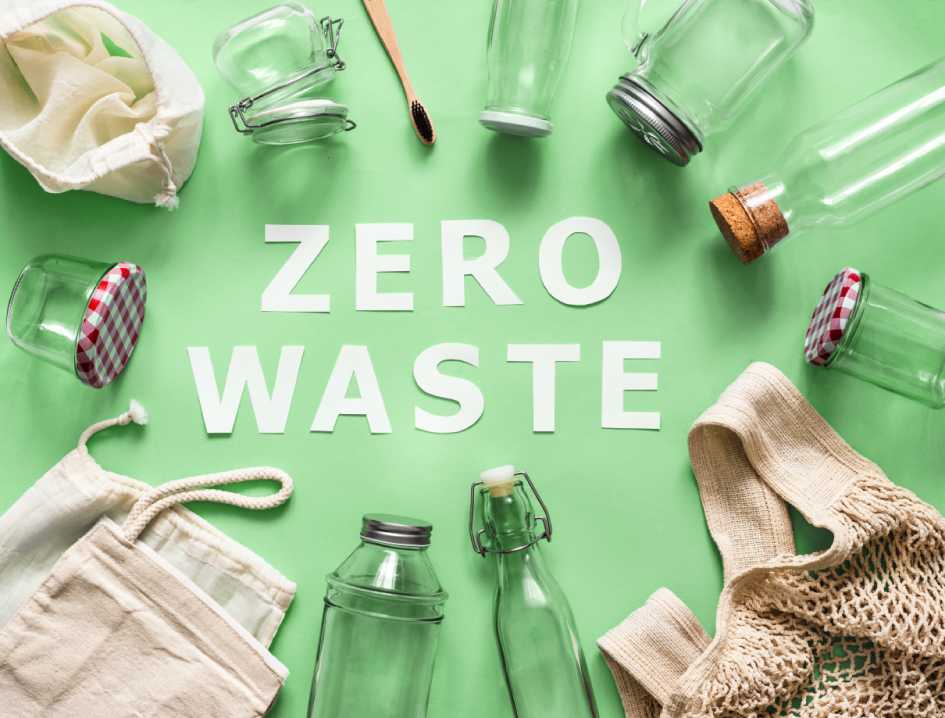Introduction
Imagine a world where your trash can stays nearly empty, and single-use plastics become a rarity. This is the essence of zero-waste living. As 2025 approaches, more busy people realize that low waste habits are both practical and beneficial. The shift is crucial because our growing trash problem harms oceans, wildlife, and our health. By adopting eco-friendly tips and aiming for Waste Reduction, you can lessen your environmental footprint. Whether you work full time or raise a family, these realistic tips will help you embrace a sustainable lifestyle without added stress.
What Is Zero-Waste Living?

At its core, zero-waste living means producing as little trash as possible. It pushes us to reuse, repair, compost, or recycle items instead of tossing them out. Though the term “zero” may seem extreme, the real goal is progress, not perfection. By choosing reusable products and avoiding single-use plastics, even those with busy schedules can cut back on waste. The rise of social media and increased awareness about pollution have made it easier to find ways to reduce trash. Small choices, like bringing your own shopping bag or cup, can spark broader lifestyle changes.
Why Zero-Waste Matters in 2025
In 2025, sustainability is no longer optional. Our planet faces challenges such as rising sea levels and plastic-filled waterways. Zero-waste living addresses these issues by stopping trash at the source. Many companies now offer eco-friendly packaging, which makes finding plastic-free products simpler. By supporting these businesses, you encourage them to keep innovating and reduce their environmental impact. You also show that consumers want responsible solutions. Reducing waste saves energy, lowers carbon emissions, and preserves resources for future generations.
Overcoming Busy Schedules
Time is precious, especially for busy people balancing work and home duties. Thankfully, zero-waste living can fit into your routine with minimal effort. Start small to avoid feeling overwhelmed. Switch to a reusable water bottle or coffee cup. This tiny step can cut hundreds of disposable cups or bottles from your yearly waste. If you have limited time for shopping, explore local markets or stores that minimize packaging. Store bags and containers in your car or purse, so you always have them on hand. Over time, these small moves become second nature.
Practical Tips for Zero-Waste Living

- Embrace Reusables
Swap disposable items for reusable ones, like metal straws, cloth shopping bags, and silicone food storage. You’ll reduce both waste and spending. - Smart Meal Planning
Plan your meals for the week, focusing on unwrapped produce and bulk items. This approach curbs impulse buys and keeps plastic waste down. - Compost at Home
Food scraps make up a large chunk of household trash. By composting kitchen scraps, you keep them out of landfills and produce nutrient-rich soil. - Rethink Single-Use Plastics
Avoid straws, plastic utensils, and plastic bags. If you dine out, bring your own container for leftovers. These habits soon feel effortless. - Buy Secondhand
Secondhand shopping for clothing or household items limits waste and saves money. Apps and thrift stores offer countless budget-friendly options.
Table: Common Items vs. Zero-Waste Alternatives
| Common Item | Zero-Waste Alternative | Benefit |
|---|---|---|
| Disposable Water Bottle | Reusable Metal Bottle | Cuts plastic pollution |
| Paper Towels | Cloth Towels | Saves trees, reduces landfill waste |
| Plastic Shopping Bags | Canvas or Cloth Bags | Eliminates single-use plastics |
| Plastic Straw | Metal or Bamboo Straw | Prevents ocean microplastics |
| Disposable Coffee Cup | Refillable Travel Mug | Reduces paper and plastic disposal |
Handling Food Waste

Food waste drains money and resources. To minimize it, cook only what you need and store leftovers in clear containers so they don’t get forgotten. Learn to interpret “best by” dates, which don’t always mean food is expired. Use your senses—if it looks, smells, and tastes fine, it’s often good. Composting leftover produce scraps or coffee grounds further reduces your trash output. Kitchen countertop bins make compost collection simple and odor-free.
Zero-Waste at Work
Whether you work in an office or from home, waste reduction is possible. Pack lunches in reusable containers, and skip individually wrapped snacks. Bring your own mug to meetings instead of using paper cups. Propose a small recycling station for paper, plastic, and cans. If your workplace offers single-serve coffee pods, switch to a French press or drip coffee maker. These changes may seem small, but they add up in a shared environment.
Simplifying Family Life
Families generate plenty of waste, from snack packaging to disposable diapers. Gradual changes can make a big impact. Buy snacks in bulk and pack them in sealable containers. If you have babies, consider cloth diapers or more eco-friendly brands. Teach kids about green living by involving them in sorting recyclables or learning about nature. When children see sustainability as fun and important, they’re more likely to keep these habits for life.
Myth: Zero-Waste Is Too Expensive

Some believe that zero-waste living costs a lot, pointing to premium plastic-free products or fancy reusable containers. Yet a sustainable lifestyle often saves money over time. Cooking at home reduces pricey takeout orders. Buying secondhand or reusing items also helps you spend less. Start with small steps, and you won’t feel pressured to invest in everything at once. Eventually, you’ll see benefits for both your wallet and the planet.
Zero-Waste Travel
When traveling, waste can pile up from disposable utensils and packaged foods. Stay prepared by bringing a reusable water bottle, a small utensil set, and a cloth bag. If you buy souvenirs, refuse plastic bags and store them in your tote. Look for accommodations that support green living, or choose rentals where you can cook your own meals. These steps help reduce trash and encourage local businesses to adopt eco-friendly tips.
Maintaining Momentum

It’s easy to slip back into old habits when life gets hectic. Set manageable goals, like reducing your weekly trash by half. Celebrate progress and adapt when you discover new solutions. Online communities focused on zero-waste living offer tips and moral support. By sharing experiences, you stay motivated and learn from others’ success stories. Each piece of trash you avoid contributes to a healthier environment.
E-Waste Concerns
Digital clutter matters, too. Old gadgets may contain toxic materials that harm soil and water. Use e-waste recycling programs or donate functional devices so they stay in use longer. Clearing out unneeded emails and files also helps reduce data center energy demand. These small actions create a broader culture of minimalism and responsible consumption.
Conclusion
Zero-waste living is achievable for busy people aiming to Reduce Trash. Every small step, from swapping disposable items for reusable ones to composting food scraps, protects the environment and saves money. This sustainable lifestyle doesn’t demand perfection—simple changes add up over time. By choosing plastic-free options, shopping smart, and staying motivated, anyone can cut their waste in 2025. Even if life is hectic, you can stay on track and inspire others to join. Let’s unite for cleaner oceans, healthier communities, and a brighter future for everyone.




